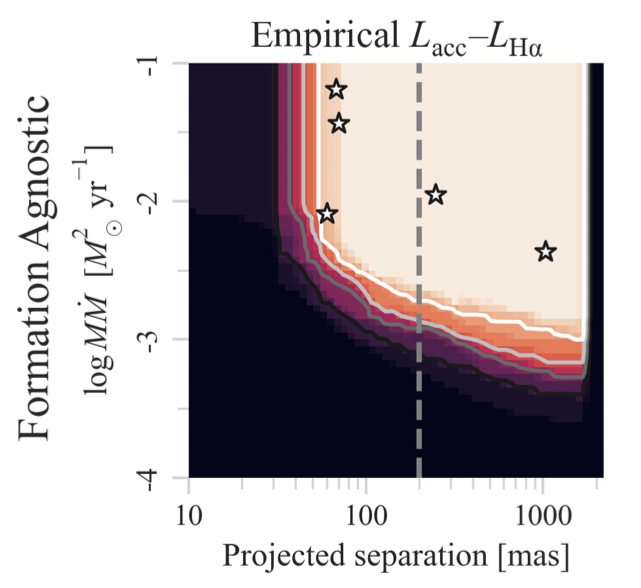Statistical Modeling of Accreting Object Populations
OVERVIEW
The accretion process constitutes a crucial phase in star and brown dwarf formation. Observational constraints on the relation between object mass and mass accretion rate show a scatter of ~5 orders of magnitude. It is not clear whether this scatter is due mostly to physical processes (e.g. accretion variability, age, varying accretion paradigms), or to systematic uncertainties arising from observational biases and inconsistencies in scaling relationships. Even more uncertainty is present in the substellar regime, where formation mechanisms are not yet fully understood and stellar derived relationships may not apply.
Simulation and statistical modeling are a key avenue to investigate and attempt to disentangle the physical and observational drivers of the scatterer in the mass-mass accretion relation. Some recent projects in this vein are described below:
-
Monte Carlo simulation allows us to juxtapose purely systematic scatter around the theoretical relation with the observed scatter, to directly compare the stellar and substellar regimes, and to closely examine discrepancies between accretion tracers. This numerical approach permits combination (or isolation) of random uncertainties, systematic uncertainties, and physical sources of scatter in a flexible framework, enabling robust statistical comparisons of heterogeneous accretion observations and physical models of star and planet formation.
Combining this technique with the uniformly redefined literature accretion measurements from CASPAR has allowed for substantial improvements in our accounting of the sources of observed scatter about the mass-mass accretion relation.
-
This 2023 senior thesis project centered around simulating the detection probabilities of exoplanets. By converting orbital parameters and accretion rates into separations and H-alpha accretion luminosities, we can compare modeled detection probabilities to observed detection rates. Comparison with the detection rates from GAPlanetS allowed us to place constraints on the occurrence rate of wide separation and close separation planetary-mass companions in transitional disk systems.
PEOPLE
PAPERS & PRESENTATIONS
Simulated Scatter: A Monte Carlo Approach to Understanding the Observed (sub)Stellar Mass-Accretion Rate Relation
We report on the results of a Monte Carlo simulation that attempts to disentangle the effects of physical processes and systematic uncertainties on the scatter in the object mass-mass accretion rate relation. This is done by unifying assumptions and propagating interrelated uncertainties throughout the extrapolation pathway from observational diagnostic to mass accretion rate estimate.
Ongoing Work
Coming Soon!










